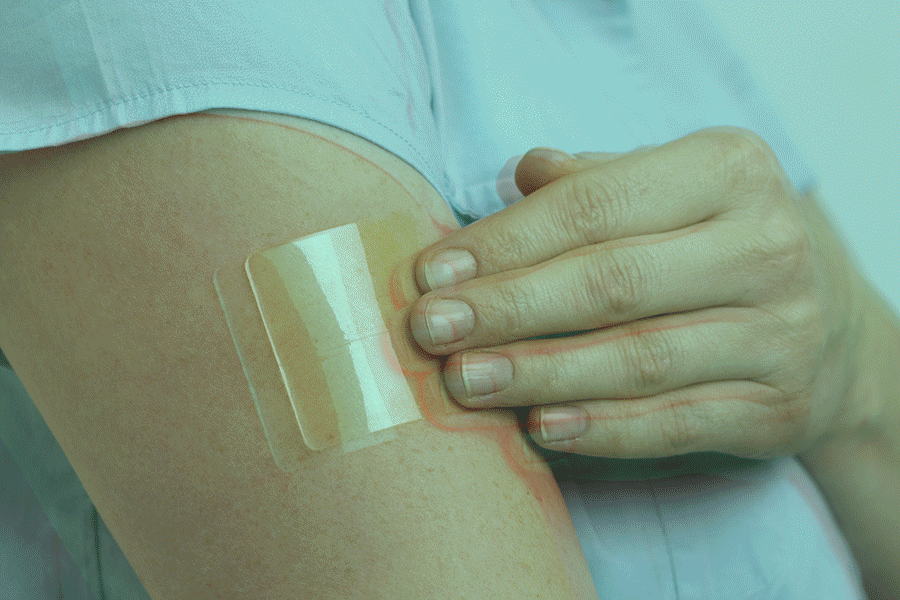
Getting drunk is great if you do it right — trouble is, most of the time we don’t. We drink too much too fast. We forget to eat first. We don’t drink enough water. We drink too many sugary drinks. We drink beer before liquor. We accept that third shot when the second was already a bad idea. So when a publicist promised to send us the No Hangover Patch, a “three-day patch charged with natural frequencies of Glutathione that when paired with hydrating and responsible drinking, reduces hangover symptoms like headaches, dry mouth, red eye, fatigue and nausea,” we were checking the mail like a rich virgin waiting on a Real Doll shipment.
Conveniently, we had to do little else. The patch takes virtually no advanced planning other than that you’re supposed to put on a circular silver patch on your back left shoulder 15 minutes before drinking. You can put a second patch on in the morning to ease symptoms. And though ours were a free sample, they aren’t that expensive for three days of worry-free imbibing. The Starter Pack costs $19.99 for a two pack (serious partiers can spring for the Ultimate Party Pack that provides 48 patches for $409.99). We imagined waking up not only without hangovers, but maybe even better than that: Maybe we’d get perfectly buzzed all night long, then pop up in the morning ready to pounce onto our day like a cheetah tackling an unsuspecting gazelle.
The instructions make it clear that users should still drink responsibly, but in order to really road-test this thing, we’d need to operate under typical drinking conditions. We decided we would each wear the patch and drink however we normally drink — which is to say, some of us are better about eating food, pacing and drinking enough water throughout the night.
That way, we could find out if this was the laziest hangover prevention possible: Do exactly the same thing we always do, only now with a tiny circular silver patch on our back left shoulder. First, though, we had some questions and some theories as to how this thing would work.
None of us knew what glutathione is — though it’s touted by many people as an effective hangover prevention ingredient. So we asked patch publicist Allison Pomrenze. “It’s an all-natural antioxidant that fights toxins — like those that come with drinking alcohol — by binding to them and making them more easily passed through the body more quickly,” Pomrenze emailed. “By wearing the patch and drinking water regularly, those toxins will leave the body faster and won’t linger in your body, thus reducing hangover symptoms in the morning.”
Uh, that made it sound like we might just piss a lot more or sweat or something. Nothing says good times like breaking the seal at double the pace or sweating booze onto our coworkers. No thanks!
“The No Hangover Patch does not increase urination frequency amongst users nor does it cause the body to sweat or lose more fluids, than normal,” Pomrenze explained. “The glutathione in the patch makes it easier for the toxins to leave the body with the fluids it normally loses anyway. By adding water to the routine, the body will stay hydrated and have more opportunity to dispense of the toxins, often through urination.”
Whew. Further research into hangover cures — which don’t exist — explain that this antioxidant is produced by the liver to help break down acetaldehyde, which causes most of the hangover shittiness, because drinking depletes it easily. A piece over at Time looking at its function in hangover prevention with a drink containing the compound, explains it this way:
Another major cause of hangover is a highly toxic byproduct of alcohol-processing called acetaldehyde, which is a known carcinogen. The liver, which processes most of the alcohol you consume, has a way to neutralize the toxin in the form of glutathione, a compound that contains the amino acid L-cysteine. (Still with me?) L-cysteine breaks down acetaldehyde into water and carbon dioxide, which are then eliminated from the body through urine.
When we drink in moderation, the glutathione in the liver keeps up — and we feel fine the next day. But when we overdo it, the liver simply doesn’t have enough glutathione to handle the acetaldehyde load. Many hangover symptoms, such as fatigue, a sore stomach, general malaise and the inability to sleep through the night are the result of an abundance of acetaldehyde: our bodies are working hard to make more glutathione and that simultaneously keeps us up, by stimulating the brain and exhausts us.
A nutritionist Time spoke with said the ingredient “sounds like a great placebo,” and said there was no evidence that simply increasing glutathione levels by ingesting it would “actually boost levels of the compound in the liver.” Other versions of the ingredient are taken in pill form. The No Hangover Patch, Pomrenze explains, isn’t ingested — it “uses frequencies to send messages to the nervous system that enable the human body to produce more glutathione.”
Other medical professionals express concern that supplemental methods to prevent hangovers haven’t undergone any rigorous studies to prove they work, and may discourage drinkers to cut loose rather than drink responsibly.
But back in No Hangover land, we are operating under the premise that the patch should theoretically somehow boost the liver in breaking down booze so we don’t suffer so horribly the next day — as long as we also drink responsibly and remain hydrated. Even though in part this defeats the point of the patch — if we drink in moderation and consume lots of water, won’t we feel fine anyway? — but armed with this idea, we optimistically patched up, went our separate ways, and reported back. Here’s what happened.
“I Woke Up the Next Morning and Wasn’t Hung Over at All”
First up, Alana Hope Levinson, MEL’s deputy editor. “I woke up the next morning and wasn’t hungover at all,” Levinson told me. “I had been drinking all day and mixing wine and hard alcohol and beer. I’m the kind of person who gets hungover from one drink. So this was INSANE.”
What’s more, she drank very little water and also skipped dinner, only stopping to eat a few late night Doritos before passing out. There was one drawback for her, though: She was wearing a tank top and the silver patch was visible to everyone at the bar and parties she attended, so people kept commenting on it. “One man at the bar claimed I was doing it ‘for attention.’ Another used it as an excuse to holler at me. And the second night a woman pulled it off thinking it was a random sticker. It doesn’t re-stick, so that sucked.”
“I Never Felt Very Drunk, Then Felt Relatively Okay the Next Day”
Nick Leftley, director of branded content and resident British guy who also writes stuff for us, drank for 12 hours straight, but incorporated water throughout his evening, as he normally does. He also had a solid lunch, some afternoon parking lot tacos for a MEL party, and a full round of “shitty diner food” at 4 a.m.
“I put the patch on when I started drinking at 3 p.m.,” he told me. “I drank a lot of beer and some whiskey during the afternoon, then more beer in the evening. As I moved later into the night/early morning, I had at least five very strong Tiki cocktails that were also stuffed full of the sort of sweet liqueurs that are normally 100 percent thudding headache hangover fuel. Despite all this booze, I don’t remember feeling especially drunk at any point, no matter how much booze I poured down my throat.”
But the next morning was a pleasant surprise. “I woke up feeling tired and a little woozy but not nauseated and without a notable headache,” he said. “I slapped on a second patch and a couple hours later, I was up and dressed and getting things done, when I wasn’t expecting to move from my bed for most of the day.”
He also had a problem with the patch staying stuck, though — one recurring, shared criticism in spite of its claim to be waterproof and last three days. “I didn’t leave them on for three days as I went in the ocean wearing a wetsuit, then showered, so they fell off within 36 to 48 hours,” he noted.
“I Feel Fine, But Not as If I Didn’t Drink”
That Friday afternoon, I slapped my patch on and started drinking Coronas around 4 pm. I had a few parking lot tacos here at the MEL offices. I kept drinking when we moved the party to a nearby bar. By night’s end, I managed to eat a normal dinner at normal dinner time, but did not have a lot of water — one glass at dinner, and again before bed. In the end, I probably drank somewhere between six to eight beers.
I don’t normally get brutal hangovers, but after that much drinking, I’ll feel queasy and have a headache. The next morning was not the cheetah pounce of my fantasies, but I had no headache and no nausea. That said, I was still super tired and sluggish for a few hours until coffee and breakfast put me back on track. I still didn’t want to do anything more than I normally would after drinking a lot. When asked how the fancy patch had treated me by a colleague, I replied, “I feel fine, but not as if I didn’t drink.”
I followed up with Pomrenze to ask about our two only real criticisms of the patch: That it seemed to reduce drunkenness for one of us, and wasn’t great at staying stuck. She assured me it does not reduce drunkenness in any way. As for the sticky factor, she said it’s “unclear how the patch will respond to other factors like salt water or a wetsuit. It sticks best if you clear off the area where you attach the patch, beforehand.”
Of course, the patch does not promise to erase all of alcohol’s effects, and what could? (Again, according to experts, nothing, except drinking less.) Plus, you’re still going to sleep like shit when you drink, which means you won’t get the same recharge overnight you would sober. I also slept in the next morning since it was a weekend, so it’s hard for me to say whether my better feelings would have been true on a weekday when I woke up two hours earlier and needed to show up at work and produce.
And of course, we can’t say whether it’s specifically placebo or patch. But for about $20, not feeling like total shit is probably worth the price in lost work and general misery — assuming it works every time.

